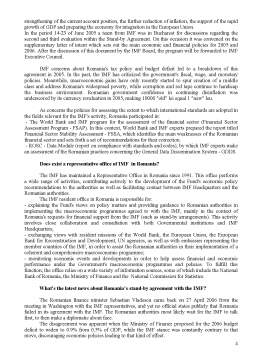Extras din referat
What is The International Monetary Fund?
The International Monetary Fund (IMF) is an international financial institution which includes 184 member states. Established in July 1945, further to the United Nations Conference in Bretton Woods (USA), IMF has as main responsibilities and objectives: the promotion of international monetary cooperation, the facilitation of the international trade balanced growth, the promotion of exchange rates stability, supply of assistance in view of the creation of a multilateral system of payments and making the general resources of the Fund temporarily available to the member states which are facing problems with the balance of payments.
On joining the IMF, each member contributes a certain sum of money called "quota subscription". The total quotas amount to SDR 212.4 billion (almost US billion), following a 45 percent quota increase effective January 22, 1999. The governing bodies are: the Board of Governors, the International Monetary and Financial Committee, and the Executive Board. The Managing Director of the IMF is Mr. Horst Kohler.
In order to attain these objectives, IMF performs three main functions: surveillance, technical assistance and financial assistance. Since the IMF was established its purposes have remained unchanged but its operations - which involve surveillance, financial assistance, and technical assistance - have developed to meet the changing needs of its member countries in an evolving world economy.
Which are the areas of activity of the IMF?
- Surveillance is the process by which the IMF appraises its members' exchange rate policies within the framework of a comprehensive analysis of the general economic situation and the policy strategy of each member.
- Financial assistance includes credits and loans extended by the IMF to member countries with balance of payments problems, to support policies of adjustment and reform. As of December 31, 1999 the IMF had credit and loans outstanding to 93 countries for an amount of SDR 57.5 billion (about US$ 75 billion).
- Technical assistance consists of expertise and support provided by the IMF to its members in several broad areas: the design and implementation of fiscal and monetary policy; institution-building (such as the development of central banks or treasuries); the handling and accounting of transactions with the IMF; the collection and refinement of statistical data; training officials at the IMF Institute and, together with other international financial organizations, through the Joint Vienna Institute, the Singapore Regional Training Institute, the Middle East Regional Training Programme, and the Joint Africa Institute.
Which are IMF financial facilities?
The IMF makes its financial resources available to member countries through a variety of financial facilities. Except for the Poverty Reduction and Growth Facility (PRGF), members avail themselves of the IMF's financial resources by purchasing (drawing) reserve assets (widely used currencies and SDRs) with an equivalent amount of their own currency. The IMF levies charges on these drawings and requires that members repurchase (repay) their own currency from the IMF with reserve assets over a specified time.
Regular IMF Facilities
Stand-by Arrangements (SBA): designed to provide short-term balance of payments assistance for deficits of a temporary or cyclical nature, such arrangements are typically for 12 to 18 months. Drawings are phased on a quarterly basis, with their release made conditional on meeting performance criteria and the completion of periodic programme reviews. Repurchases are made 31 to 5 years after each purchase.
Extended Fund Facility (EFF): designed to support medium-term programmes that generally run for three years, the EFF aims at overcoming balance of payments difficulties stemming from macroeconomic and structural problems. Performance criteria are applied, similar to those in stand-by arrangements, and repurchases are made in 41 to 10 years.
Concessional Assistance
Poverty Reduction and Growth Facility (PRGF): established as ESAF in 1987, enlarged and extended in 1994, and further strengthened in 1999 to make poverty reduction a key and more explicit element. The purpose of the facility is to support programmes to strengthen substantially and in a sustainable manner balance of payments positions, and to foster durable growth, leading to higher living standards and a reduction in poverty. Eighty low-income countries are currently PRGF-eligible.
Heavily Indebted Poor Countries (HIPC) Initiative: The HIPC Initiative, adopted in 1996, provides exceptional assistance to eligible countries to reduce their external debt burdens to sustainable levels, thereby enabling them to service their external debts without the need for further debt relief and without compromising growth. It is a comprehensive approach to debt relief which involves multilateral, Paris Club, and other official and bilateral creditors. Assistance under the HIPC Initiative is limited to PRGF and IDA eligible countries that have established a strong track record of performance under PRGF- and IDA-supported programmes. It is expected that as many as 36 IMF members could qualify for assistance under the enhanced Initiative.
Other Facilities
Compensatory Financing Facility (CFF): provides compensatory financing for members experiencing temporary export shortfalls or excesses in cereal import costs. Repurchases are made over 31 to 5 ears.
Supplemental Reserve Facility (SRF): provides financial assistance for exceptional balance of payments difficulties due to a large short-term financing need resulting from a sudden and disruptive loss of market confidence.
Contingent Credit Lines (CCL): is aimed at preventing the spread of a crisis. While the SRF is for use by members already in the throes of a crisis, the CCL enables countries that are basically sound and well managed to put in place precautionary financing should a crisis occur. If needed, short-term financing will be provided to help members overcome the balance of payments financing needs arising from a sudden and disruptive loss of market confidence due to contagion, and largely generated by circumstances beyond the member's control.
The IMF provides emergency assistance to countries that have experienced a natural disaster or are emerging from conflict. Emergency loans are subject to the basic rate of charge, although interest subsidies are available for PRGF-eligible countries, subject to availability. Loans must be repaid within 3¼–5 years.
Preview document
Conținut arhivă zip
- International Monetary Fund.doc


















